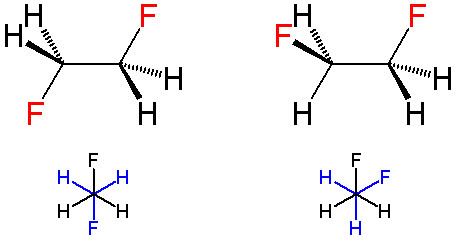 | ||
The term "gauche" refers to conformational isomers (conformers) where two vicinal groups are separated by a 60° torsion angle. IUPAC defines groups as gauche if they have a "synclinal alignment of groups attached to adjacent atoms".
In stereochemistry, gauche interactions hinder bond rotation. For example, sighting along the C2–C3 bond in staggered butane, there are two possible relative potential energies. The two methyl groups can be in an anti-bonding relationship, or offset at sixty degree dihedral angles. In the latter configuration, the two methyls are said to be in a gauche relationship, and the relative potential energy of each methyl-methyl gauche interaction is 0.9 kilocalories per mole (4 kJ/mol). In general a gauche rotamer is less stable than an anti-rotamer.
Gauche effect
The Gauche effect characterizes any gauche rotamer which is less stable than the anti rotamer. This effect is present in 1,2-difluoroethane (H2FCCFH2) for which the gauche conformation is more stable by 2.4 to 3.4 kJ/mole in the gas phase. Another example is 1,2-dimethoxyethane.
There are two main explanations for the gauche effect: hyperconjugation and bent bonds. In the hyperconjugation model, the donation of electron density from the C–H σ bonding orbital to the C–F σ* antibonding orbital is considered the source of stabilization in the gauche isomer. Due to the greater electronegativity of fluorine, the C–H σ orbital is a better electron donor than the C–F σ orbital, while the C–F σ* orbital is a better electron acceptor than the C–H σ* orbital. Only the gauche conformation allows good overlap between the better donor and the better acceptor.
Key in the bent bond explanation of the gauche effect in difluoroethane is the increased p orbital character of both C–F bonds due to the large electronegativity of fluorine. As a result, electron density builds up above and below to the left and right of the central C–C bond. The resulting reduced orbital overlap can be partially compensated when a gauche conformation is assumed, forming a bent bond. Of these two models, hyperconjugation is generally considered the principal cause behind the gauche effect in difluoroethane.
The molecular geometry of both rotamers can be obtained experimentally by high resolution infrared spectroscopy augmented with in silico work. In accordance with the model described above, the carbon–carbon bond length is higher for the anti-rotamer (151.4 pm vs. 150). The steric repulsion between the fluorine atoms in the gauche rotamer causes increased CCF bond angles (by 3.2°) and increased FCCF dihedral angles (from the default 60° to 71°).
In the related 1,2-difluorodiphenylethane (two protons replaced by phenyl) the threo isomer is found (by X-ray diffraction and from NMR coupling constants) to have an anti conformation between the two phenyl groups and the two fluorine groups and a gauche conformation is found for both groups for the erythro isomer. According to in silico results this conformation is more stable by 0.21 kcal/mol (880 J/mol).
A gauche effect has also been reported for a molecule featuring 4 successive fluor syn substituents, the last one introduced by deoxofluorinating agent bis(2-methoxyethyl)aminosulfur trifluoride:
The gauche effect is very sensitive to solvent effects, due to the large difference in polarity of the two conformers. For example, 2,3-dinitro-2,3-dimetylbutane, which in the solid state exists only in the gauche conformation, prefers the gauche conformer in benzene solution by a ratio of 79:21, but in carbon tetrachloride it prefers the anti conformer by a ratio of 58:42. Another case is trans-1,2 difluorocyclohexane, which has a larger preference for the eq/eq conformer in more polar solvents.
A related effect is the alkene cis effect.
